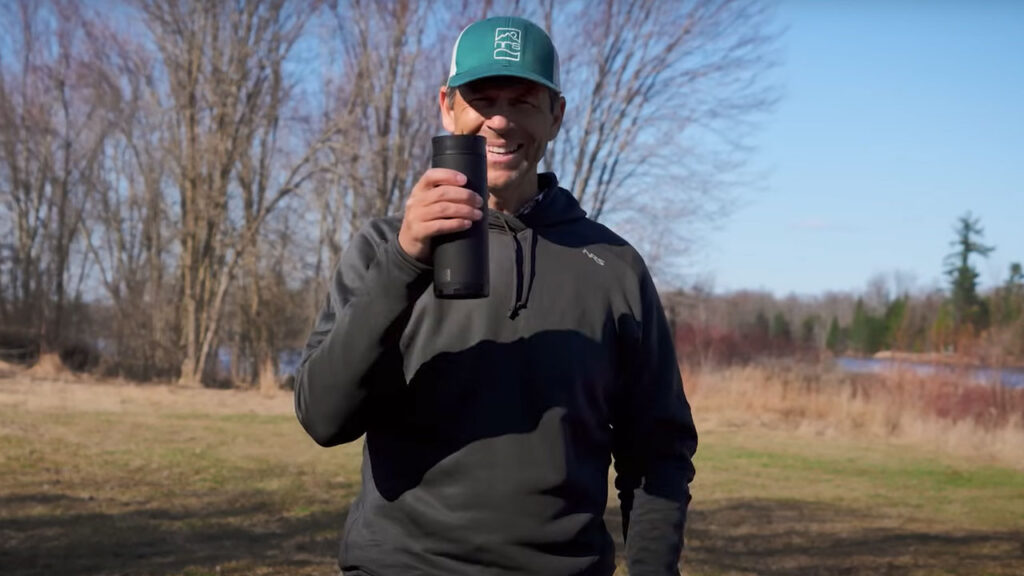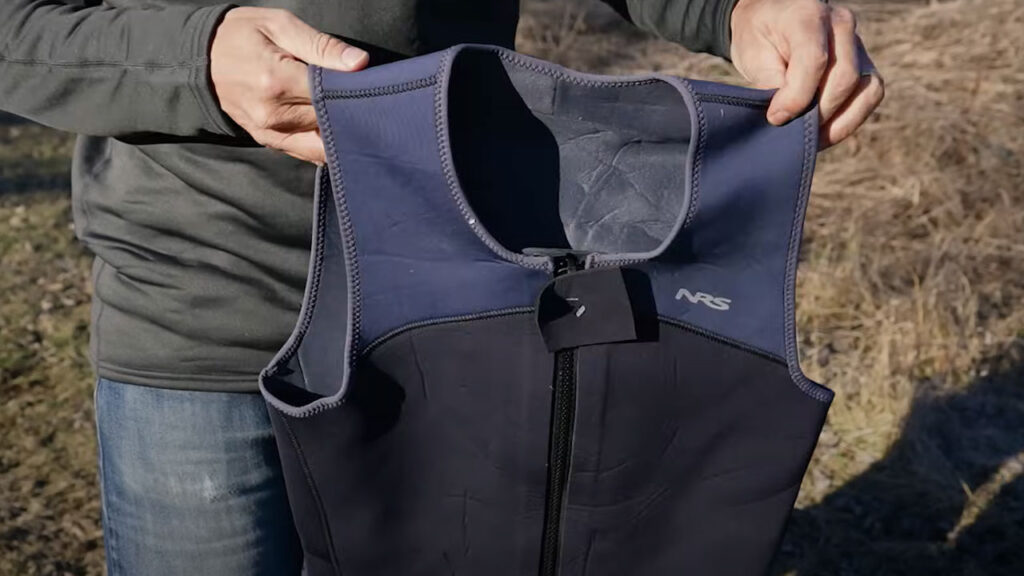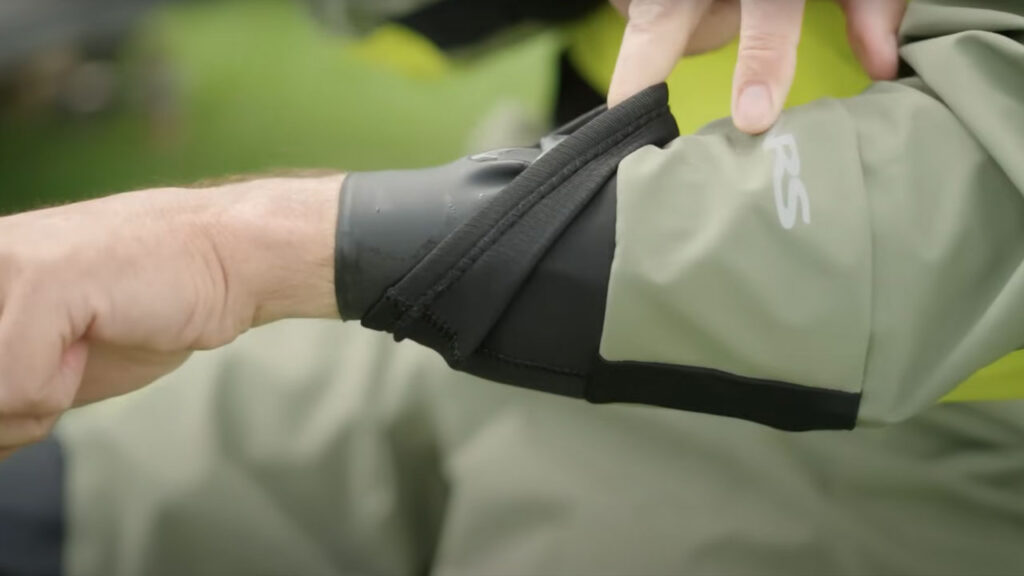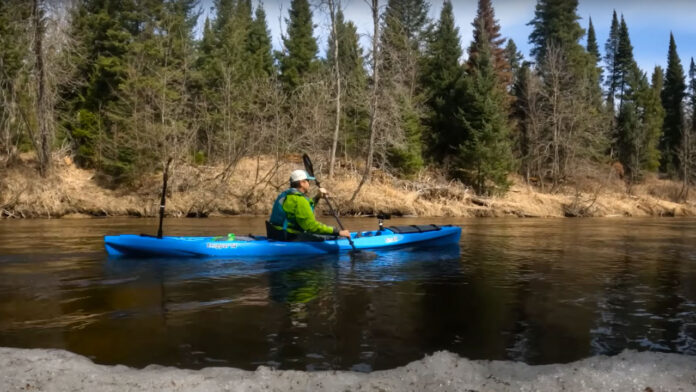Spring is one of the most exciting times for kayakers who, like me, live in a place with real winters. The ice is finally starting to melt, the days are getting longer, and the sun is getting warmer. It is time to get back on the water and paddling. So here are five spring paddling tips to help you make the most out of your early season paddling.
1. Spring paddling tips #1: Give Your Gear Some Love
You rely on your gear as a kayaker, so you have to keep it well-maintained. Spring is the right time to maintain your gear, so here are some ways to keep it well-maintained.

Waterproofing Treatment
In Spring, the weather and the water are colder. Depending on where you live, it can still be freezing. So, when on the water, you will need your dry wear to stay dry. Dry gear needs to be treated with a waterproofing treatment for it to keep working well.
Waterproofing treatments are easy to use, and there are many options available. My go-to is Nikwax, which I have been using Nikwax for a decade.
303 Protectant
The 303 Protectant spray has been a go-to product in the kayaking industry for many years. It protects your gear in a variety of ways.
It protects the gaskets on your dry suit or top from drying out and cracking and is also a UV protectant. Therefore, 303 Protectant protects anything likely to be hit by the sun. For example, it helps keep kayaks from fading or deteriorating due to harmful UV rays. To use it, all you do is spray the product on a surface and wipe it down with a rag.
2. Start Slowly
Likely over the winter, you have not paddled much, if at all. So, you should not expect that you can still do the things you were doing at the end of the last paddling season. It is an easy trap to fall into.
The problem with diving straight into a big day of paddling is that it can lead to overuse injuries. These might simply be blisters on your hand. However, it could lead to something worse, such as tendonitis in your wrist or shoulder. Overuse injuries like tendonitis can stop you from paddling for a longer chunk of time. So, when you start kayaking again at the beginning of the season, it is important to lower your expectations. Do not try to paddle as far, and don’t try to do as much as you were at the end of last season. Instead, work your way up to the longer, harder paddles.
Another good idea to avoid injury is to do some related exercises before you get back into your boat. Doing this allows your body to get back into shape for paddling. These exercises can be as simple as push-ups. When I know the paddling season is about to begin, I start doing daily push-ups. I start strengthening my body and getting it ready.

3. Bring an Emergency Kit
An emergency kit is a dry bag filled with items you might need in an emergency, such as extra gear. In the springtime, temperatures can often drop significantly at the end of the day. You need to prepare for changing conditions in case you are out on the water longer than you intended. Extra gear can mean extra layers (tops and bottoms), hats, gloves, or anything that will keep you warm on the water.
If you intend to travel further from shore, your emergency kit needs to contain gear that will help you keep warm overnight. In springtime, there is always the risk that you might get caught in a storm and be unable to get back to your starting point. In that case, you need to have gear that will allow you to survive camping out overnight. It does not have to be comfortable, but you do need to be able to survive.
In a situation like this, the things you bring depend on where you are. It can include items like a fire starter, a lighter, a knife, zip ties, and a rope. Extra food, snacks, and water are also essential. You need to bring anything that you can fit in one or two dry bags that will, in a pinch, help you survive.
The worst situation you can be in is being stuck on the water, feeling like you need to push through unsafe conditions to get back home just because you are underprepared. Bring an emergency kit so you can be more comfortable if things do not go as planned out on the water. And, so you can spend an emergency night out on the water if needed.

4. Bring a Thermos
The easiest way to improve a Spring paddling trip is to bring a thermos. Bring a thermos with something warm to drink. I can guarantee that everyone in your group will love you. They will especially love you if you bring my favorite drink: baileys and hot water! One part of Baileys with eight to ten parts of hot water makes a delicious Baileys tea.
If you bust a thermos out with something warm and tasty, your friends will love you. Not only that, but it really can change the mood of a trip, especially when people are a little cold and down in the dumps. So make sure to bring a thermos with something warm to drink.
5. Dress for Immersion
Dressing for immersion is the biggest tip I can give anyone paddling in Spring conditions. At this time, the water is colder than usual, so you have to dress to be able to handle an unexpected swim.
There is not a one-size-fits-all solution to what to wear. It depends on factors such as how cold the water is, the air temperature, how long you might be in the water, and how far away you will be from a warm and dry place. If it is cold conditions and you are soaking wet, your battle against hypothermia is not over until you can get to a place of warmth. All of these factors play a role in how you dress for immersion.
In the Coldest Conditions
In the coldest conditions, you only have two choices. You have to either use a wetsuit or a dry suit.

Wetsuits
The benefit of a wetsuit is that it is much cheaper than a dry suit. Other than that, there are not too many benefits. Wetsuits do the job and provide a great option for paddling in cold conditions.
The neoprene in a wetsuit insulates you when it is wet. It holds a thin layer of water between you and the neoprene itself. Your body heats that water, and the neoprene layer lets you keep the heat in. For a wetsuit to work most effectively, the wetsuit needs to be form-fitting. Otherwise, the insulating layer does not work effectively.
Wetsuits work, which is why you see surfers in the freezing cold ocean using them and staying warm enough while active. However, wetsuits are not as good an option as dry suits for paddling. The reason for that is that dry suits keep you completely dry. Wearing a wetsuit means you need to be wet!

Dry Suits
Dry suits keep you dry because they have gaskets. Rubber gaskets on your neck, wrists, and ankles provide a waterproof seal. The suit is made from a waterproof, breathable material that lets you wear even your street clothes underneath it and stay dry. However, street clothes are not the right gear for paddling in the Spring.
The dry suit does a great job of keeping you completely dry but does not provide insulation. So, underneath the dry suit, you need to wear layers that will insulate you. How many and which layers depend on how cold it is. But it is always a good idea to wear several different layers. That way, you can take layers off or add layers if you need to.
I always wear a thin layer of merino wool as a base layer on both the top and bottom. I then wear a thicker fleece layer over the top of those. The size of this layer depends on the temperature outside. The joy of these materials is that they are moisture-wicking fabrics. Any sweat is pulled away from my body and does not cool me down.
A dry suit is the ultimate protection against the cold but is expensive. It is one of those things that is worth buying if you intend to spend a lot of time out on the water in cold conditions. However, if you are not, it might be better to wait for warmer weather before you get out on the water.

On your feet
My go-to shoe when paddling in cold conditions is the NRS Boundary boot. I have used this boot for over a decade because it is so good. It is a wetsuit boot, but unlike a wet suit, it is fully waterproof unless you step into deep water and the water gets over the cuff. So it keeps your feet warm.
I wear the NRS Boundary boot over a dry suit with feet. That way, I can wear socks inside my dry suit and then put my warm, waterproofed, and socked feet into the shoe. So, there is no way my feet will get wet, even if I step into deep water. That makes for toastie feet. If you intend to wear a wetsuit boot over a dry suit, buy a wetsuit boot that is a little bigger than your usual boot. That way, you have space for the dry suit and socks!

On your hands
When it comes to keeping your hands warm, there are several choices. There are, for example, wetsuit mitts and gloves. You can find wetsuit mitts and gloves in many styles and thicknesses.
You can also use something called pogies. To use pogies, you attach them to your paddle using velcro over the top of the paddle. Then, you slide your hands into the pogie and hold your paddle as normal. The joy of using pogies is that you have direct contact with your paddle. Pogies are ideal to use when performance is important, for example, when paddling in rough conditions. Due to the direct contact with your paddle, they allow you to have more control.
I did, however, recently learn a limitation of pogies. At the beginning of the winter, I took a multi-day trip alone. To keep a long story short, while I was resting my boat floated away by itself. I had to swim after the kayak. Luckily, I had a dry suit on because the weather was below-freezing. But because I was using pogies on that trip, I ended up swimming with bare hands. Despite only being in the water for about a minute, my hands were numb and useless with no gloves. Until they warmed up, I could not do anything.
This experience was a bit of a wake-up call that, while paddling, pogies are my favorite. However, you cannot always gear up based on the best situation, instead, you have to plan your gear for the worst-case scenarios. In cold conditions, the worst-case scenario is going for a swim. So, learning from that, next time I paddle in very cold conditions, I will not use pogies but will wear something that will allow me to manage a swim much better.
In Cool Conditions
When the conditions are not as cold but are still cool, you should still dress for immersion. You still need to dress in a way that will let you survive a swim – whether it is comfortable or not.
There are lots of different options for what to wear in cool conditions. So, you may not need to wear a wet suit or dry suit, but you might be able to wear a paddling top or splash top with no gaskets. If the water is not too cold, you may not need to stay fully dry, so a splash top could be sufficient.
In cool conditions, you will always need to wear layers – and particularly moisture-wicking layers. These layers should be moisture-wicking and insulating to keep you warm. The one rule is that you should never wear cotton while out on the water when it is cold because it does not insulate when it is wet. Cotton does the opposite. It draws warmth from your body. So, on hot days, a cotton T-shirt is not a bad idea – but that is a different story. In cool water, in springtime, do not wear cotton.
In cooler conditions, I often wear the NRS Hydroskin, which has a wetsuit material on the outside and a fleece inside. It acts like a wetsuit when it is wet and insulates when it is both wet or dry. I will then add different layers of fleece. But the great thing about these layers is that they last a long time if looked after properly.

On your feet and hands
In cooler conditions, booties are a great option to wear on your feet. I use wetsuit boots made of neoprene and designed to insulate when dry or wet. I will use this style of boot until it gets too hot to use them anymore.
If your hands get cold quickly, several different types of light gloves can take the edge off of the cold.
The reality of paddling in the Spring is that you need to have the right gear. If you intend to paddle in cold conditions, you need to invest in the right gear because hypothermia is a real thing that can creep up on you. Gear up and make conservative decisions in the Spring to keep yourself safe.
Happy paddling!

Cold Water Gear: NRS Flux Dry Top, NRS HydroSkin Pants, NRS Boundry Boots, NRS Wetsuit, NRS Pogies, NRS Wetsuit Booties
Kayaks: Swell Watercraft Scupper 14
Paddles: Aqua Bound Manta Ray
PFD: NRS Zen PFD, NRS Ninja Lifejacket








